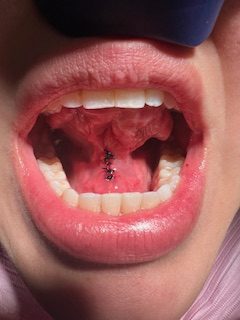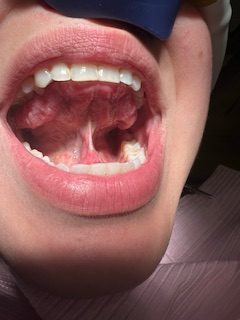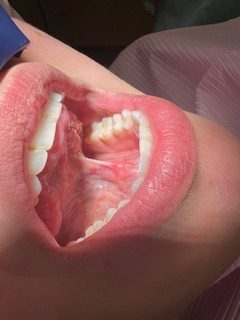services
Tongue Tie Release
Our Services
Dr. Rusta is highly trained in Airway and tongue tie release. She has trained by Dr. Zaghi and Dr. Chelsea Pinto at the Breath institute and is a graduate from Baxter Academy. She continuously follows Dr. Bagheri , Dr. Zaghi and their lectures to stay on top of the latest research in this field.
Tie Release in Adults, Children, and Babies
Adults
Tongue tie release, also known as frenectomy or frenuloplasty, can be performed on individuals of all ages who are experiencing symptoms related to tongue tie. Although often addressed in infancy or childhood, some people may not receive a diagnosis or treatment until adulthood.
For adults, the procedure is similar to that performed on children but may require more specialized techniques due to the thicker and more developed frenulum. Typically done under local anesthesia, general anesthesia might be used for more complex cases. The healthcare provider will make an incision in the frenulum to release the restriction. Depending on the severity of the tongue tie, additional steps, such as stitching or advanced surgical techniques, may be taken to ensure proper healing and restore tongue function.
Before the procedure, it’s crucial to ensure that there is adequate space for the tongue to function and rest in the palate, often achieved with orthodontics. After the release, adults may be advised to perform exercises and stretches to aid in tongue function and prevent reattachment of the frenulum. Speech or myofunctional therapy might also be recommended to address any related speech or swallowing difficulties.
If you suspect you have tongue tie and it is causing symptoms, consult a healthcare professional specializing in oral and maxillofacial surgery, ENT surgery, or related fields for evaluation and treatment recommendations.
Babies
Tongue tie release in babies, known as ankyloglossia, is considered when the lingual frenulum is abnormally short or tight. This condition can lead to several issues:
- Feeding Difficulties: A tight frenulum can restrict tongue movement, affecting breastfeeding or bottle-feeding. Babies may struggle to latch properly, leading to inadequate feeding and poor weight gain.
- Weight Gain Issues: Difficulty feeding can result in insufficient weight gain, crucial for a baby’s growth and development.
- Pain for the Mother: Breastfeeding difficulties can cause pain, discomfort, and nipple damage for the mother. Correcting tongue tie can alleviate these issues.
- Speech and Language Development: Untreated tongue tie might affect speech and language development, causing articulation and pronunciation difficulties.
- Oral Hygiene: Restricted tongue movement can hinder effective oral hygiene.
- Comfort and Function: Addressing tongue tie improves overall comfort and oral function, enabling activities like sucking, swallowing, and speech.
- Cranial Development: Proper tongue positioning ensures better palate development and airflow through the nose. A tethered tongue can cause nasal airway blockage and mouth breathing.
Tongue tie release in babies is a simple procedure performed by a pediatrician, dentist, or oral surgeon. Releasing the tight frenulum allows the tongue to move freely, improving feeding and comfort.
If you or your lactation consultant suspect tongue tie is causing feeding or other issues, consult a healthcare provider experienced in assessing and treating tongue tie for proper diagnosis and treatment options.
Adults’ Symptoms
Adults with tongue tie may experience various symptoms, including:
- Speech Difficulties: Challenges with pronouncing sounds that require significant tongue movement.
- Oral Hygiene Issues: Difficulty cleaning the mouth, leading to dental problems.
- Chewing and Swallowing Problems: Difficulty moving food, causing choking or discomfort.
- Oral Health Issues: Increased risk of bad breath and potential teeth alignment issues.
- Mouth Breathing: Preference for mouth breathing due to tongue positioning.
- TMJ Issues: Potential contribution to TMJ disorders and jaw pain.
- Sleep Disordered Breathing: Association with sleep apnea due to airway function impact.
- Lingual Frenulum Pain: Discomfort or pain during tongue movement.
- High Blood Pressure: Possible link to high blood pressure.
Not all adults with tongue tie experience severe symptoms, and the impact can vary. If tongue tie is causing difficulties, consult a healthcare professional specializing in relevant fields for assessment and treatment recommendations
Tongue tie release in our office
Dr. Rusta uses a variety of tools to perform a release. The most commonly used tools are CO2 laser and scissors or a combination of both. The use of CO2 laser will ensure that there won’t be any thermal damage to the tissue.




What Makes Us Different?
professional & experienced
As a highly skilled and experienced dentist, I provide exceptional patient care through advanced techniques, meticulous attention to detail, and a compassionate approach to oral health.
Affordable rates
Our dental office offers top-quality care with affordable rates to ensure that excellent oral health is accessible to everyone.
customer satisfaction
At our dental office, we prioritize customer satisfaction by delivering personalized care and ensuring a comfortable, positive experience for every patient.
